

Millennium Micro Modal Beechwood Towel
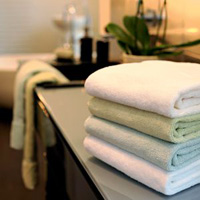
Coshmere Supima Substainable Life Towel
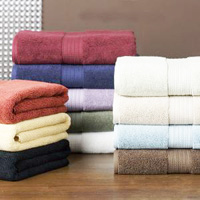
Regency Low Twist Towels

Loop Organic 650 GSM Towels
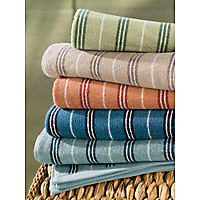
Cambridge Stripe Towel
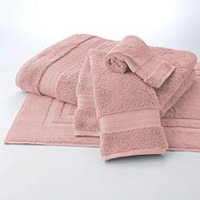
Kohl's Supima Luxury Collection
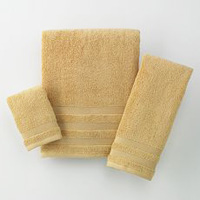
Kohl's ELS Microcotton Luxury Collection
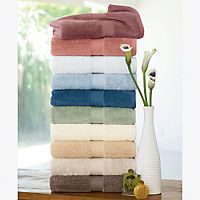
Organic Cotton Towels
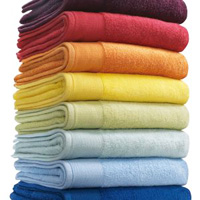
Sensitive Certified Organic Towels
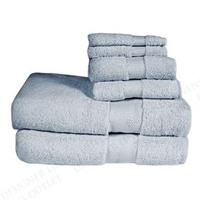
Supima Cotton Towel Sets
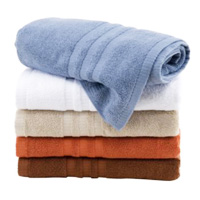
The Great Indoors Bellino Egyptian Cotton

Kohl's 2 ply Cotton/Bamboo Vera Wang Towel
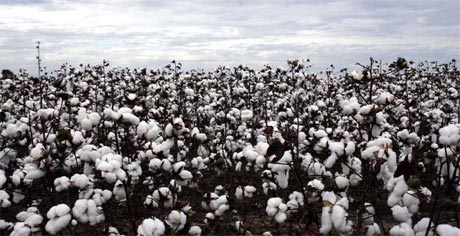
Cotton is a soft, staple fiber that grows in a form known as a boll around the seeds of the cotton plant, a shrub native to tropical and subtropical regions around the world, including the Americas, India and Africa. The fiber most often is spun into yarn, used to make a soft and breathable textile. It is the most widely used natural-fiber textile in clothing and home furnishings today.
Top ten cotton producers — 2007
(480-pound bales)
| COUNTRY | BALES 2007 |
|---|---|
| People's Republic of China | 25.3million bales |
| India | 20.5million bales |
| United States | 19.2 million bales |
| Pakistan | 11.7million bales |
| Brazil | 7.2 million bales |
| Uzbekistan | 5.5 million bales |
| Turkey | 3.2 million bales |
| Greece | 1.4 million bales |
| Turkmenistan | 1.3 million bales |
| Syria | 1.2 million bales |
In India, the states of Maharashtra (26.63%), Gujarat (17.96%) and Andhra Pradesh (13.75%) are the leading cotton producing states. These states have a tropical wet and dry climate.
In the United States, Texas is the highest in total production, and California has one of the highest yield per acre in the world.
Production of cotton does vary year to year in every country depending upon the climate. The amount of rain will effect the production per acre every year. That is why the price of cotton will change from season to season and country to country.
Cotton towels release soil
easily, so they wash clean. The fiber provides cool comfort in the summer and holds a
layer of warm air in the cold weather. They also have one the highest wear
resistance of all the principal textile fibers and cotton becomes softer
with repeated washings and use. It is also now generally accepted that cotton
is kind to the skin of eczema sufferers or people with sensitive skin.
Cotton will withstand high temperatures and takes dyes easily. Chlorine bleach can be used to restore white towels to a clear white but this bleach may yellow chemically finished cottons or remove color in dyed cottons. Boiling and sterilizing temperatures can also be used on cotton without disintegration. Cotton can also be ironed at relatively high temperatures, stands up to abrasion and wears well.
Cotton products can typically be machine washed and dried. Colored cotton garments retain their color longer if they are washed in warm or cool water. Sunlight will harm cotton by causing it to oxidize and turn yellow. Fabrics that are 100% cotton do shrink if they have not been treated with a durable-press or a shrinkage-resistant finish.
More information regarding cotton may be found at www.cotton.org
Botanically, there are three principal groups of cotton that are of commercial importance. The first, Gossypium hirsutum, is native to Mexico and Central America and has been developed for extensive use in the United States, accounting for more than 95 percent of U.S. production. This group is known in the United States as American Upland cotton, and varies in length from about 7/8 to 1 5/16 inches (22.2mm to 33.3mm) . A second botanical group, G. barbadense, which makes up the balance of U.S. production, is of early South American origin. Varying in length from 1 1/4 to 1 9/16 inches (31.7mm to 39.6mm), it is known in the United States as American Pima, but is also commonly referred to as Extra Long Staple (ELS) cotton. A third group, G. herbaceum and G. arboreum, embraces cottons of shorter length, 1/2 to 1 inch (21.2mm to 25.4mm), that are native to India and Eastern Asia.
In a single pound of cotton, there may be 100 million or more individual fibers. Each fiber is an outgrowth of a single cell that develops in the surface layer of the cottonseed. During the early stages of its growth, the fiber elongates to its full length as a thin–walled tube. As it matures, the fiber wall is thickened by deposits of cellulose inside the tube, leaving a hollow area in the center. When the growth period ends and the living material dies, the fiber collapses.
As you can see there are just in the United States three different types of cotton. The same situation exists in every country growing cotton. Thus, just because a label tells you that the cotton came from a certain country, does not mean the cotton was of the highest quality for a towel.
Also please note that now that almost all of the towel production is NOT in the United States. The United States Cotton producers are exporting a large percent of their product to other countries such as India, China, Pakistan and others. So, it very possible that the towel may be made in India from American cotton.
Lets take Egyptian cotton as an example, the label on the towel may say the cotton was from Egypt. But there are Giza 45, 70, 88,76,and 77 in the long staple category, Giza 67, 69 and 75 in the Long-Medium category and Giza 66 and 72 in the Medium category for staple length.
Example would be Giza 87 in the Extra Long staple length 35.2-37.2 mm or Giza 88 cross between Giza 45 and Giza 77at 35.0-35.1 mm.
On top of that, the length of the staple of every kind of cotton changes from year to year.
Take a look at the average length of the staples for two different kinds of Egyptian cotton over several seasons below.
Physical Properties of Egyptian Cotton (Giza 70), Seasons 19/92 - 1997/98
| PHYSICAL PROPERTIES | 92/93 | 93/94 | 94/95 | 95/96 | 96/97 | 97/98 |
|---|---|---|---|---|---|---|
| AVG LENGTH | 32.0 | 32.2 | 31.9 | 31.1 | 31.3 | 32.1 |
| MICRONAIRE GR/IN | 3.90 | 3.70 | 3.60 | 4.00 | 3.73 | 3.88 |
| % MATURE FIBERS | 79 | 79 | 76 | 77 | 74 | 76 |
| TRASH % WEIGHT | 3.6 | 4.4 | 4.6 | 4.2 | 3.6 | 3.3 |
Source : CATGO, Alexandria, 1998
As you can see the fiber length, micronaire (avg. thickness of the fiber), percentage of mature fibers and the percentage of trash in the bales will vary from year to year. This is true of all cotton producing fields, all over the world.
Grading cotton is of the utmost importance in both marketing and manufacturing. The buyer's usual method is to cut a slit through the bale (About 480 lbs of cotton staple) wrappings and pull out a handful of the lint, upon which judgment will be passed. Sometimes samples of the lint are taken from two sides of the bale. These samples are carefully examined by sight, touch, and smell. The length and consistency of fiber are noted; the coarseness or fineness of the fiber is considered, and also its breaking strength. Since the cotton is bought and sold by the pound, it is necessary to determine if it contains substances, which unduly increase the weight, such as dirt, leaves, or undue moisture. Some moisture is always found in cotton fibers, but the amount should not average more than two or three per cent. of the total weight. If there is more moisture than this, the cotton sells for less. Both dead and unripe fibers are objectionable and lower the grade. Fibers damaged by frost or by insects are also of poor value. Finally the buyer considers the color and luster of the fiber. Upon the basis of all of these considerations, the grade of the cotton is determined. The bales are weighed; a certain percentage of the total weight, usually four per cent. is taken off for coverings and dirt. Then the farmer is paid for the net amount of cotton. The usual test for moisture is simply by feeling. Any mildew is detected by its odor.
Cotton grading is imperfect, and there is considerable play of chance in grading a bale. One bale of cotton contains the fiber from say two and one-half acres of land. Almost certainly there are great variations in the cotton, due to differences in the land. If the sample comes out of the best cotton, the bale brings a higher price than if the sample happens to be of the poorer cotton therein. A good many mistakes are possible in grading cotton. Any two graders, even if expert, seldom grade cotton alike, and it is by no means certain that the same grader could twice grade the same cotton in exactly the same way. The difficulty is often complicated by incompetence and sometimes by dishonesty.
The standard grades: After the length and the strength have been established, the degrees of color, luster, and cleanliness give rise to thirteen distinct grades generally recognized in all cotton markets in this country. These grades from highest to lowest are as follows:
1. Fair
2. Strict middling fair
3. Middling fair
4. Strict good middling
5. Good middling
6. Strict middling
7. Middling
8. Strict low middling
9. Low middling
10. Strict good ordinary
11. Good ordinary
12. Strict ordinary
13. Ordinary
Of the grades in the above list, those designated as "strict" are commonly spoken of in the trade as "half-grades." Some cotton markets, notably New York, formerly recognized quarter grades also. These were found impracticable after several years of trial.
Any discoloration in the cotton is noted in the grade by using the words "tinged" and "stained"; for instance, "strict good middling tinged," "good ordinary tinged," or "low middling stained." Tinged cotton is only moderately discolored. Stained cotton may range anywhere from a light yellow to a deep red or, as it is called in the trade, "foxy" color.
The basis grade in all markets is "middling" white cotton. This grade is the universal standard by which the quality of all other grades is measured. It is fleecy cotton, very nearly white in color, and containing only a small amount of foreign matter. "Fair" cotton, the highest grade recognized, is very bright, white, clean cotton. The other grades down to "ordinary" contain an increasing amount of foreign matter, and the lowest grades usually are somewhat dingy. Below "low ordinary" are some miscellaneous classes of cotton for which there are no recognized grades and which are of poor value.
Cotton can stand high temperatures and takes dyes easily. Chlorine bleach can be used to restore white garments to a clear white but this bleach may yellow chemically finished cottons or remove color in dyed cottons. Boiling and sterilizing temperatures can also be used on cotton without disintegration. Cotton can also be ironed at relatively high temperatures, stands up to abrasion and wears well.
Cotton products can typically be machine washed and dried. Colored cotton garments retain their color longer if they are washed in warm or cool water. Sunlight does harm cotton by causing it to oxidize and turn yellow. Fabrics that are 100% cotton do shrink if they have not been treated with a durable-press or a shrinkage-resistant finish.
Cotton classification is used to determine the quality of the cotton fiber in terms of grade, length of staple and Micronaire (Fiber diameter). USDA classification specifically identifies the characteristics of fiber length, length uniformity, strength, Micronaire, color, preparation, leaf and extraneous matter. In the past, these qualities were classified just by hand-and-eye of an experienced classier. Since 1991, all classification has been carried out with a set of up-to-date instruments, called "HVI"(High Volume Instrumentation) classification. However, measuring techniques of other qualities of cotton fiber, such as fiber maturity and short fiber content, are also being developed.
More information regarding cotton may be found at Cotton Inc.
Fiber length is defined as the average length of the longer one-half of the fibers (upper half mean length). Fiber length is basically an inherited/genetic character of the seed variety. However, weather, nutrient deficiencies, as well as excessive cleaning and/or drying at the gin may also affect the fiber length. By affecting yarn strength and evenness, and the efficiency of the spinning process, the length of the fiber has a great influence on quality and price.
According to the USDA's classing methodology, length measurement of American upland cotton is performed by HVI in accordance with standard test methods. The length of staple, measured in inches and fractions of an inch, is classed according to the following codes:
| Length inches (mm) | Code |
|---|---|
Consumers should always be looking for the best quality cotton products
made from an extra-long staple cotton ( ELS cotton). The long fibers of
ELS cotton make a stronger and more softer yarn, and, in turn, weave into a
much stronger and softer fabric. Most high thread count sheets are made from
ELS cotton because a long fiber is needed to make a very thin, yet strong,
yarn. Among the ELS cottons are Pima, Supima and Egyptian cotton. ELS cotton is grown in most countries in the world that produce cotton. In India for an example, MCU5 and Shanker 6 are both extra long staple cotton that is very similar to Egyptian cotton. In fact if we have a towel made in the same factory using the same size yarns and processing of Egyptian cotton, Pima Cotton and MCU5 from India you could not tell the difference. An expert in towels might be able to tell, but you as a consumer most likely could not tell.
Egyptian cotton is a fine, lustrous, long staple cotton grown in
Egypt. Usually staple length of 34mm-37mm. Long staple cottons are more expensive than the commonly available
Cottons, because they are synonymous with quality and have a higher thread
count.
Just because the label says the cotton is Egyptian cotton does not mean that it was from the best Egyptian cotton, it could very well have been made from short fiber Egyptian cotton and not be any better than the cotton grown in any other country.
First, we have to understand that in Egypt, just like in every other country that grows cotton in the world, there are cotton plants that grow short staple, medium staple, long staple and extra long staple cotton. So just because the cotton came from Egypt, does not mean that it is the fine extra long staple cotton you would expect.
Second, we must remember that towel mills in Egypt can import cotton from other countries, as well, so they could have imported cotton from the Sudan or Pakistan and made your towel from that cotton and put “Made in Egypt” on the towel.
Third, many factories have been known to blend Egyptian cotton with lesser quality cottons to make the product less expensive. A towel may say on the Sew in Label that the product is of 100% Egyptian cotton Loops, but in reality, the Egyptian cotton was only 30% and the other 70% was of a lesser quality cotton or another local ELS cotton to reduce the cost. I do not want to put all of the blame on the factory, the retailer must assume part of the responsibility as they may have forced the factory to meet a price point that was unreasonable. In addition, that local ELS cotton that was blended with the Egyptian, may have been just as good of quality cotton as the imported Egyptian cotton. You might not even know the difference. The reasonable retail price for a real Egyptian cotton towel should be $8.99-14.99 for a 30 x 54 bath towel. Given the actual price of real Egyptian cotton, it would almost be impossible to build a medium to heavy weight Egyptian Cotton towel in a 30 inch width for less money.
Your best bet to secure good Egyptian cotton is to look for the Pyramid with the eye at the top logo of the Egyptian Cotton Council. This usually means that the cotton being used is of the best quality and not blended with another quality of cotton.
Pima cotton is a generic label given to any ELS cotton grown
in any country from a particular type of long-staple cotton. In the United States Pima can be called Pima or Sea Island cotton. Usually with staple length of 33mm-36mm. Pima has most all of the same properties of Egyptian, including softness, luster and strength. The correct price point for a 30 inch bath towel in Pima would be around $7.99-$9.99. Kohl's has an very good Pima towel called Apartment 9 which is a good example of Pima yarns in a big 30" x 56" size.
Turkish Cotton is many time considered an Extra Long Staple Cotton. The truth behind this is the same as for Egyptian Cotton. In Turkey as in India, Brazil and many other countries they do grow excellent long staple cotton. They also grow short staple cotton just like everyone else. When looking at Turkish cotton towel be sure the feel the product and look for a brand that you know has taken the time to assure the cotton in the towel is Extra Long Staple Turkish cotton. Christy of England make an excellent 2 ply Hotel Towel worth considering.
Other Extra Long Staple cottons would include Indian MCU-5 cotton sometimes trademarked as Kashmir Cotton, because of its soft and silky feel, with a staple length of 34mm-36mm. As you can see this cotton staple length is very similar to Pima but without the popular brand name, is less expensive and usually in a price point of $6.99-$9.99 for the same 30 inch bath towel.
Supima cotton is very similar to Egyptian cotton, and is as good or better than Egyptian cotton. Supima is grown in the southwestern United States and is a form of Pima cotton. Usually of 35mm-38mm staple length. Supima also has the same properties of Egyptian, softness, luster and strength. I personally feel that Supima is slightly better than Egyptian. But the best part of Supima is the control the Supima Cotton Council has on the product. The Supima council controls which factories can purchase and produce Supima products and they also control which retail outlets can sell the Supima towels. You can find Supima products ( sheets, blankets and towels) only in better Department Stores and Specialty Shops. You will not likely find Supima products in mass merchants or discount stores. The correct price point for Supima bath towel in a 30 inch width would be similar to Egyptian at $9.99-$14.99 price point or even more at better department and specialty stores.
Check out the Kohl's Supima Luxury Collection Towel made with 100% American Supima in a extra large 30" x 58" bath size.
Organic Cotton is cotton that is grown using methods and materials that have a low impact on the environment. Organic production systems replenish and maintain soil fertility, reduce the use of toxic and persistent pesticides and fertilizers, and build biologically diverse agriculture. Third-party certification organizations verify that organic producers use only methods and materials allowed in organic production.
Organic cotton is grown without the use of toxic and persistent pesticides and synthetic fertilizers. In addition, federal regulations prohibit the use of genetically engineered seed for organic farming. All cotton sold as organic in the United States must meet strict federal regulations covering how the cotton is grown.
How much organic cotton is grown globally?
Organic cotton grown by farmers worldwide increased 152 percent during the 2007-2008 crop year, according to the Organic Cotton Farm and Fiber Report 2008 released by Organic Exchange. As a result, organic cotton production reached 145,872 metric tons (MT), equaling 668,581 bales, grown on 161,000 hectares in 22 countries.
Approximately 60 percent of the total represents expansion of known projects, while the remaining 40 percent represents data from new projects becoming certified or previously unknown projects. According to the report, the production increase was driven in large part by the heightened demand for organic cotton from small- to large-sized retailers around the world.
India took over Turkey’s long-standing position as the leader, seeing its production increase by 292 percent to reach 73,702 MT, or about half of world organic cotton production. Other leading organic cotton producers, according to rank, were Syria, Turkey, China, Tanzania, United States, Uganda, Peru, Egypt and Burkina Faso.
How much organic cotton is grown in the U.S.?
In 2008, U.S. acreage planted with organic cotton increased for the second straight year, according to research compiled by the Organic Trade Association (OTA). Analysis of available data found that the total acres planted in organic cotton grew from 8,510 in 2007 to 9,279 in 2008, constituting a nine percent increase.
Harvest acreage figures for 2008 are not yet available. Other findings show 14,025 bales of organic cotton were harvested in 2007, representing a 73 percent increase over the previous year, when the total number of bales was 8,116. The U.S. organic cotton harvest represents about 2.1 percent of total global organic cotton production.
To compile the research, the OTA surveyed organic cotton farmers in the United States who grew organic cotton in 2007, and combined those results with acreage and harvest figures from the Texas Organic Cotton Marketing Cooperative. Ten of 62 farms surveyed returned surveys that met the criteria for analysis. The OTA’s survey, funded by Cotton Inc., asked about the types of cotton planted and harvested. Survey respondents planted 2,590 acres of organic upland cotton and 245 acres of organic pima cotton. In 2007, survey respondents harvested 1,716 acres of organic upland cotton and 225 acres of organic pima cotton.
Please make a note that while Organic cotton will save the environment close to 140 grams (about 1/3 of a pound) of fertilizer per bath sheet, growing any cotton uses at least 925 gallons (around 3,500 liters) of water to produce a single pound of cotton. And 60% of the water used to irrigate cotton is lost to evaporation and poor irrigation practices.
Cost of organic cotton
While the organic cotton industry is doing very well, it's still in its infancy. Growing organic cotton is a labor-intensive process. Also, given the crop rotation requirements, it means that growers harvest less. This increased labor and decreased production does reflect in the price of 100% organic cotton garments. But some companies are minimizing price increases by using blends of organic and non-organic cotton.
Misleading companies
When buying organic cotton items, check to see if it's 100% or blended. If it's the latter and an amount isn't stated, there's a possibility that as little as 5 - 30% of the cotton used in the item is organic. You'd be surprised at how many of the big name brands have tried to fool consumers using this strategy. If in doubt, contact the company and ask them straight out "what percentage of organic cotton is used.
Third party inspection Organizations
Look for certifications using the Global Organic Textile Standards, Skal Certified Organic Cottons, and Oeko-Tex certified dyes being used for coloration. These independent organizations are valuable in making you secure that you are really getting organic products. The "Cradle to Cradle" organization pushes for complete use of biodegradable materials including the label, the yarns, and the threads to assure return to dust products.
Organic cotton - truly sustainable?
While the attempts of some cotton producers to produce a more earth-friendly product are surely admirable, it's my understanding that given the nature of the cotton plant it will always be an industry that requires incredible, and perhaps unsustainable amounts of water. If impact on water supplies is something that's of great concern to you in your purchase towels, you may want to investigate alternative fibers for your towels, such as hemp or perhaps hemp and organic cotton blends.
As regenerated cellulose fiber, bamboo fiber is 100% made from bamboo through a high-tech process. The raw material in bamboo was originally from well-selected, non-polluted regions in Yunnan and Sicuan Province, China. They are all 3-4 year old bamboo plants. Today, as this fiber is more popular, it is grown in many places in southeast Asia. More important, bamboo fiber is a unique biodegradable textile material. As a natural cellulose fiber it can be 100% biodegraded in soil by microorganisms and sunshine. The decomposition process does not cause any pollution in the environment. "Bamboo fiber comes from nature and completely returns to nature in the end". Bamboo fiber is praised as "the natural, green and eco-friendly new-type textile material of 21st century".
It is a common fact that bamboo can thrive naturally without using any pesticide. It is seldom eaten by pests or infected by pathogens. Bamboo fiber has particular and natural functions of anti-bacteria, bacteriostatic and deodorization Bamboo fibers natural anti-bacteria function differs greatly from that of chemical anti microbial that may cause skin allergy.
What is notable of bamboo fiber is its unusual ability to breathe and its coolness. Because the cross-section of the bamboo fiber is filled with various micro-gaps and micro-holes, it has much better moisture absorption and ventilation. With this unparalleled micro-structure, bamboo fiber towels can absorb and evaporate moisture quickly.
Bamboo fiber resembles cotton in its un spun form, a puffball of light, airy fibers. Many companies use extensive bleaching processes to turn bamboo fiber white. Although most towel manufacturers producing organic bamboo fabric leave the bamboo fiber unbleached. To make bamboo fiber, bamboo is heavily pulped until it separates into thin component threads of fiber, which can be spun and dyed for weaving into terry fabric. The fiber is naturally smooth and round without chemical treatment, meaning that there are no sharp spurs to irritate the skin.
Companies trying to use sustainable textiles, because the bamboo plant is very quick growing and does not usually require the use of pesticides and herbicides to thrive, favor bamboo fabric. As a result, plantations can easily be kept organic and replanted yearly to replenish stock
In textile form, bamboo retains many of the properties it has as a plant. Bamboo is highly water absorbent, able to take up three times its weight in water. In bamboo fabric, this translates to an excellent wicking ability that will pull moisture away from the skin so that it can evaporate.
Bamboo also has many antibacterial qualities, which bamboo fabric is apparently able to retain, even through multiple washings. This helps to reduce bacteria that thrive on towels and cause unpleasant odors
There are some excellent Bamboo/Cotton towels on our More Shopping page.
Lyocell is a fiber made from wood pulp cellulose. It was first manufactured in 1987 by Courtaulds Fibres UK. The only current manufacturer in the United States is Lenzing Inc, who markets it under the trademarked brand name Tencel.
The Federal Trade Commission defines Lyocell as "a cellulose fabric that is obtained by an organic solvent spinning process". It classifies the fiber as a sub-category of rayon.
Tencel® is the registered trade name for Lyocell, which is a biodegradable fabric made from wood pulp cellulose. It started to grow in popularity in the late 1990s, and now you can find a variety of towels made with the fabric.
Most compare the original Tencel® garments to rayon in feel, but it can be made in different forms.
The manufacturer of Tencel® claims the fabric to be environmentally friendly and a good choice for people with sensitive skin. Yet this may not always be true. While Tencel® is made from wood fibers and is biodegradable, it is difficult to dye the fabric without treatment with a number of different chemicals that are neither environmentally friendly nor suitable for people with sensitive skin
If washed in cold water, Tencel® garments shrink about 3% with the first washing, but then won’t shrink in future washes. Tencel® also dries quickly, so drip-drying it may not take long.
Tencel® is more absorbent than cotton, and can make for quick drying after your morning shower.
It has a soft finish, packs light and is made from cellulose wood pulp, typically a mix of hardwood trees like oak and birch. This makes it a natural fabric, and it is noted for its durability and strength, in addition to its eco-friendly manufacturing techniques.
Tencel is made by chipping wood, breaking down the wood fibers with the non-toxic chemical amine oxide, and then placing the material in a spinneret. The spinneret produces long fibers, which are then dried and woven into cloth.
Like other natural fibers, Tencel is naturally biodegradable. Tencel is yarn dyed and absorbs colors much better than most other fibers, and it is particularly striking in deep tones, taking on a jewel-like appearance. Lyocell can be made into micro fibers (very fine fibers), offering depth and body to fabrics combined with luxurious drape. Short staple length fibers give a cotton-like look to fabrics. Long filament fibers give the finished fabric more silk-like qualities. The best forms of Tencel for toweling are a blend with cotton.
As stated, before Tencel is more absorbent than cotton or silk, but slightly less absorbent than wool, linen, or rayon. Tencel has good resiliency: it does not wrinkle as badly as rayon, cotton, or linen.
Want to know what that fabric is? The Burn Test is a quick way to determine the fiber content of an unknown fabric:
In a well-ventilated area, and away from flammable materials, unravel a few threads of the fabric in question. Lighting a match or lighter, move the sample slowly first up to the flame and then into it, watching carefully. Remove it from the flame, still watching it and extinguish it if necessary.
Tencel fibers won't shrink from the flame, will burn with a yellow flame while in it, continues to burn when the flame is removed, and smells like burning wood. There is a little gray ash residue after extinguishing. Rayon, a close cousin of Tencel, reacts exactly the same, so it is difficult to tell these apart.
Rayon is one of the most peculiar fabrics in commercial use today. Strictly speaking, it is not an artificial fiber, because it is derived from naturally occurring cellulose. It is not, however, a natural fabric, because cellulose requires extensive processing to become rayon. Rayon is usually classified as a manufactured fiber and considered to be “regenerated cellulose”.
Rayon is the oldest manufactured fiber, having been in production since the 1880s in France, where it was originally developed as a cheap alternative to silk. Rayon drapes well, is easy to dye, and is highly absorbent, although it tends to age poorly. Many rayon products yellow with age and pill or form small balls and areas of roughness where the fabric is most heavily worn.
The manufacture of rayon begins with cellulose, frequently extracted from wood pulp. Although any plant material with long molecular chains is suitable. The cellulose is steeped in caustic soda, which concentrates some of the cellulose into soda cellulose, which is then rolled or pressed to remove excess soda solution. After pressing, the cellulose is shredded into a substance called white crumb.
The white crumb is allowed to oxidize, forming shorter molecular chains, and treated with carbon disulfide. The soda cellulose reacts with this substance, forming yellow crumb due to inorganic compounds that emerge during the chemical process. This yellow crumb is dissolved in a caustic solution, which relaxes the hydrogen bonds in the cellulose, producing a highly viscose substance. This substance gives its name to the manufacturing process, called the viscose process.
This viscose fluid is allowed to age, breaking down the cellulose structures further to produce an even slurry, and then filtered to remove impurities. Small air pockets are forced out to ensure a strong, even fiber, and the mixture is forced through a spinner, which forms many even strands of fine thread that enter a setting solution to form cellulose filaments: also called rayon.
This complex process results in a great deal of environmental pollution, inspiring a drive to clean up the industry. The rayon industry has also suffered from the development of cheaper artificial fabrics with a much shorter manufacturing process, such as nylon. Rayon is frequently blended with true synthetic fabrics for various applications, and it is advisable to follow individual care labels on rayon garments, as these blends have specific handling needs.
Rayon is known by the names viscose rayon and art silk in the textile industry. It usually has a high luster quality giving it a bright shine.
Rayon is a very versatile fiber and has the same comfort properties as natural fibers. It can imitate the feel and texture of silk, wool, cotton and linen. The fibers are easily dyed in a wide range of colors. Rayon fabrics are soft, smooth, cool, comfortable, and highly absorbent, but they do not insulate body heat, making them ideal for use in hot and humid climates.
The durability and appearance retention of regular rayon are low, especially when wet; also, rayon has the lowest elastic recovery of any fiber.
Modal is a processed bio-based textile made from reconstituted cellulose from the beech tree. It is very soft and popular for both clothing and household textiles such as bedding, upholstery, and towels. Modal may be used on its own or in a blend with cotton, spandex, or other textiles. In many ways, modal acts like cotton, but it also has some significant advantages over cotton.
Modal is considered a type of rayon. While rayon may be made of the wood pulp of a number of different trees, modal uses only beech wood. Modal is considered bio-based rather than natural because, though the raw materials used to make it are natural, they are heavily processed using a number of chemicals.
Like other types of rayon, originally marketed as "artificial silk," modal is soft, smooth and breathes well. Its texture is similar to that of cotton or silk. It is cool to the touch and very absorbent. Like cotton, modal dyes easily and becomes color-fast after submersion in warm water.
One of the advantages of modal over cotton is its resistance to shrinkage, a notorious problem with cotton. Modal is also less likely to fade or to form pills as a result of friction. Its smoothness also makes hard water deposits less likely to adhere to the surface, so the fabric stays soft through repeated washings.
The textile has particularly taken off in Indian companies. In the United States, modal is most often seen in bed sheets, towels, and robes, popularized in part by Bed, Bath & Beyond. However, it is slowly gaining ground as a clothing material as well. In Europe, where the fabric originated, it is already widely used in clothing as a replacement for cotton.
I want to make a comment about a property of all four fibers we just discussed. All of these unique fibers are very absorbent and therefore when they become wet, they have a tendency to become very limp. For a towel this is a problem. The loops of the towel will fall down and become limp reducing the bulkiness or pushiness of the towel. I highly suggest that if you are interested in purchasing a towel which includes these fibers in the towel, that you be sure that the towel is of 2 ply yarns. We will discuss plied yarns in the next chapter, but having a blend of 65%-75% cotton and one of these fibers, made with 2 ply yarns, will help keep your towel looking thick and thirsty even after you have used the towel.. These are excellent fibers to be used in a towel, but only if blended with a larger percentage of cotton and made with 2 ply yarns.
You might want to look at the Christy Embrace Towel which is a blend of 48% COTTON, 30% MODAL and 22% SILK, what a nice towel.
The hemp plant is harvested for its fibers, seed, seed meal and seed oil.
Hemp is a distinct variety of the plant species cannabis sativa L. Due to the similar leaf shape; hemp is frequently confused with marijuana. Although both plants are from the species cannabis, hemp contains virtually no THC (delta-9-tetrahydrocannabinol), the active ingredient in marijuana.
Hemp cannot be used as a drug because it produces virtually no THC
(Less than 1%), where marijuana produces between 5 - 20 % THC.
The valued primary fibers are contained around the hollow, woody core of the hemp stalk. These long, strong fibers that grow the length of the hemp stalk are considered bast fibers. Hemp fiber possesses properties similar to other bast fibers (flax, kenaf, jute and ramie) and excels in fiber length, strength, durability, absorbency, anti mildew and anti microbial properties.
Once a hemp crop has matured and been harvested, hemp primary fibers are separated from the hemp stalk through the "retting" process. For "dew retting", the cut stalks are left in the field for several weeks to allow natural humidity and bacteria to decompose the fiber-binding pectin's. Other ways to separate the fiber from the core are: water retting, warm water retting and chemical retting. When the retting process is complete, the fibers are readily separated from the core, and processed for specific products.
Primary fibers are long-staple length fibers, averaging 8 ” (20 cm) in length. These hemp fibers can be spun and woven to a fine, crisp, linen-like fabric and used for apparel textiles, home furnishing textiles and carpeting. Anti mildew and anti microbial properties make them very suitable for sails, tarps, awnings, and floor coverings.
Primary fibers can be cut to shorter staple lengths to accommodate a variety of spinning systems. Hemp fiber blended with wool, cotton, linen or other fibers, adds strength, durability, absorbency and breathable, making hemp-blended fabrics cool and comfortable to wear and touch.
Characteristics of hemp fiber are its superior strength and durability, resistance to ultraviolet light and mold, comfort and good absorbency, almost 150% of its own weight. The original Levi Strauss jeans were made from lightweight hemp canvas. Hemp rope is notorious for breaking due to rot as the capillary effect of the rope-woven fibers tended to hold liquid at the interior, while seeming dry from the outside.
This is an excellent fiber for making a towel. I highly recommend this fiber for a towel that you will give you years of use and be extremely absorbent.
Well, we have learned about the different kinds of cotton and cotton blends that make most of the towels in the world. but now we have to take the raw cotton and spin the fibers into yarn before we can weave a towel.
So let us go to the spinning factory and learn how to make yarns, just click on About Yarn.
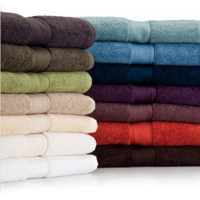
Supreme 800 GSM Egyptian Towel
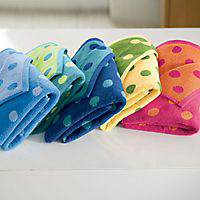
Reversible Dots Towels
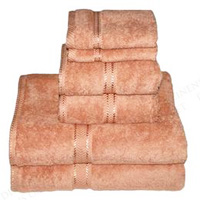
Christy Renaissance Egyptian Cotton Towels
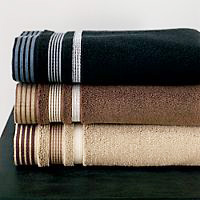
Metro Towels
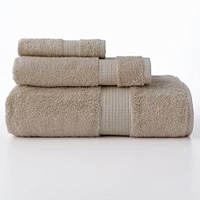
Kohl's Pima Apt 9 Towel
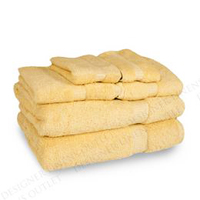
Egyptian Cotton Towel Sets
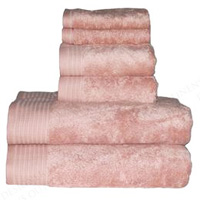
Christy Embrace Cotton/Model/Silk Towels
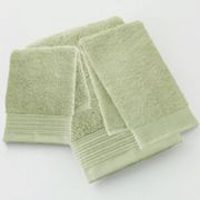
Kohl's Organic Towel
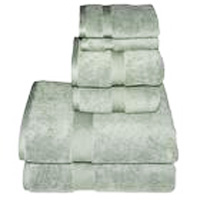
Christy Hotel 2 ply Turkish Cotton Towels
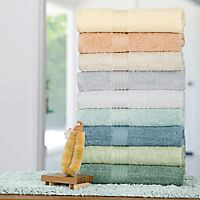
Bamboo Solid Towels